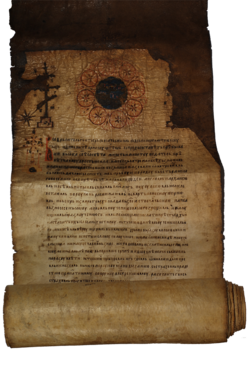Dečani chrysobulls
| Charter of Dečani | |
|---|---|
 Original first page | |
| Also known as | Dečani charter |
| Date | 1330 |
| Place of origin | Kingdom of Serbia |
| Language(s) | Old Serbian |
| Author(s) | Stefan Uroš III |
| Dedicated to | Visoki Dečani |
| Exemplar(s) | Archive of the Serbian Academy of Sciences and Arts |
The Dečani chrysobulls (Serbian: Дечанске хрисовуље/Dečanske hrisovulje) alternatively known as the Dečani charters (Дечанске повеље/Dečanske povelje) are chrysobulls dating to 1321-1331 which contains a detailed list of landholdings and tax farming rights which the monastery of Visoki Dečani held over settlements and communities in an area which spanned from southern Serbia, Kosovo,[a] Montenegro and parts of northern Albania. The chrysobulls were signed by King Stefan Uroš III Dečanski of Serbia who confirmed existing rights and gave new ones to the monastery.
King Stefan Dečanski (r. 1321–1331) mentioned that the court dignitaries present at the Dečani assembly were the kaznac, tepčija, vojvoda, sluga and stavilac.[1]
The chrysobulls did not list every settlement in the domain of Serbian kings, but only those whose taxes were directly used for the benefit of the monastery. The chrysobulls listed that Visoki Dečani held such rights over 2,097 households of meropsi (dependent farmers-serfs), 266 Vlach households (pastoral communities) and 69 sokalniki (craftsmen).[2] The settlements listed in the first charter region were mostly ethnically Serb.[3] Most of the Albanians at the time were Catholic and as such might not have been listed in the documents of Serbian Orthodox monasteries. Some of those listed as "Vlachs" might have actually been Albanian-speakers.[4]
The total of 89 settlements with 2,666 households were recorded of which 86 settlements were Serb (96,6%) and 3 (3,3%) were Albanian.[5]
Annotations[]
- ^ The political status of Kosovo is disputed. Having unilaterally declared independence from Serbia in 2008, it is formally recognised as an independent state by 97 UN member states (with another 15 recognising it at some point but then withdrawing recognition), while Serbia continues to claim it as part of its own sovereign territory.
References[]
- ^ Srđan Šarkić (1996). Srednjovekovno srpsko pravo. Matica srpska. p. 66. ISBN 9788636303696.
- ^ Fine 1994, p. 318.
- ^ Milica Grković, 2004, First charter of Dečani: Dečanski hrisovulja ili raskošni svitak Archived 2011-08-26 at the Wayback Machine, Zbornik Matice srpske za književnost i jezik, vol. 52, iss. 3, pp. 623-626
- ^ Guy Brunet (2004). Minorities. Peter Lang. p. 147.
- ^ Pavle Ivić and Milica Grković, 1976, Dečanske hrisovulje, , (Serbo-Croatian)
Sources[]
- Fine, John Van Antwerp (1994). The Late Medieval Balkans: A Critical Survey from the Late Twelfth Century to the Ottoman Conquest. University of Michigan Press. ISBN 978-0-472-08260-5.
- Ivić, Pavle; Grković, Milica (1976). "Dečanske hrisovulje". Institut za lingvistiku u Novom Sadu.
{{cite journal}}: Cite journal requires|journal=(help) - Šarkić, Srđan (1996). Srednjovekovno srpsko pravo [Medieval Serbian law] (in Serbian). Matica srpska. ISBN 9788636303696.
- Ivić, Pavle; Grković, Milica (1976). "Dečanske hrisovulje". Institut za lingvistiku u Novom Sadu.
{{cite journal}}: Cite journal requires|journal=(help)
- Golden Bulls
- Medieval charters and cartularies of Serbia
- 14th century in Serbia
- Nemanjić dynasty
- Demographic history of Serbia
- Serbian history stubs